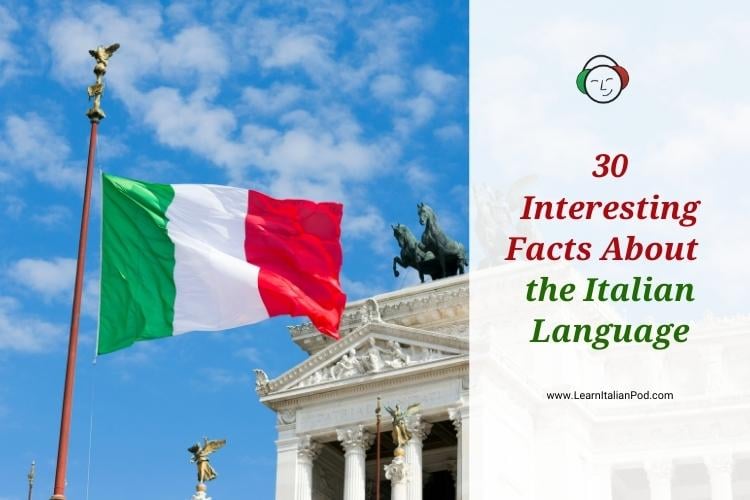30 Interesting Facts About the Italian Language
Searching for interesting facts about the Italian language? You’re in the right place.
I am an Italian native, and I’ve dedicated countless hours to teaching international students the melodious and rich Italian language.
In this article, I’ll share carefully researched and interesting Italian language facts, so all you have to do is embark on this literary journey and enjoy the linguistic ride!
Planning a trip to Italy? Dive into this detailed guide, featuring 135 essential Italian travel phrases, complete with a PDF cheat sheet.
Historical Evolution of the Italian Language

1. The Florentine Dialect Became the Official Language of Italy in 1861
Italy was a patchwork of separate states with various dialects until the unification in 1861, which brought about a decisive change in the linguistic landscape.
The Florentine dialect was chosen as the official language, partially due to its prestigious literary heritage. This choice symbolized national unity but was initially a challenge since only 3-5% of the population spoke it regularly at that time.
It took many years for standardized Italian to penetrate all regions of the newly unified country.
2. The Italian Language Stems Directly from Latin Roots
The history of the standard Italian language is deeply rooted in Latin, the language of the Roman Empire. Following the collapse of the Empire in the 6th century, Latin evolved into various dialects across the Italian peninsula. This process, over the centuries, laid the foundation for modern Italian.
Dante Alighieri, the renowned writer of “The Divine Comedy,” played a crucial role in this evolution. His use of the Tuscan vernacular helped to establish it as a literary language, earning him the title of ‘Father of the Italian Language.’
Related Reading: 10 Famous Latin Quotes and Meanings: Wisdom Unveiled
3. The Beginnings of Written Italian Date Back to 960-963
Italian language’s literary heritage is rich and complex. While many famous works date back to the 14th century, the earliest examples of a language resembling Italian are the Placiti Cassinesi, legal documents from 960-963.
These texts provide insights into the language’s development, marking a transitional phase from Latin to the various Romance languages.
4. Italy’s Linguistic Diversity: A Rich Symphony of Dialects
Italy’s varied and unique dialects reflect its multifaceted cultural identity. Dialects developed independently from Latin and were shaped by historical, geographical, and social factors.
Even today, regional dialects are the mother tongue for approximately half of Italy’s inhabitants, contributing to a rich tapestry of linguistic diversity. Some dialects, such as Neapolitan, are so distinct that they could almost be considered separate languages.
5. Alessandro Manzoni’s “I Promessi Sposi” Is the Most Widely Read Italian Novel
Alessandro Manzoni’s novel, “I Promessi Sposi” (“The Betrothed”), initially published in 1827, is a pivotal work in Italian literature. Revised to adhere to standard Italian between 1840 and 1842, this book is hailed as the nation’s first modern novel.
Integral to Italy’s public education system, generations have delved into its pages as part of their schooling.
Related Reading: 17 Best Italian Books: Explore Italy’s Rich Culture
6. Television Catalyzed the Standardization of the Italian Language in the 1950s and 1960s
The emergence of television in the 1950s and 1960s played a pivotal role in the Italian language’s standardization. With the spread of national broadcasts, people across Italy were exposed to standardized Italian, promoting a more unified linguistic identity.
Italian television shows helped bridge linguistic gaps and even assisted in literacy campaigns. The influence of television acted as a catalyst for reducing regional disparities in language, fostering a sense of national identity and cohesion.
Suggested Reading: 30 Best Italian Shows on Netflix to Watch
Facts About the Italian Language Globally

7. 85 Million People Speak Italian Worldwide
Italian is not just confined to Italy. It has spread across continents. Over 85 million people in the world speak Italian. Its influence can be seen in various international domains such as art, music, food, and fashion.
Furthermore, Italian is one of the four official languages of the European Union, reflecting its status as a key cultural and political voice in Europe.
8. Italian is the Official Language of Many Other Countries
The Italian language reaches beyond Italy’s borders, serving as an official language in four nations. It holds official status in the Republic of San Marino, the southern region of Switzerland, select coastal areas of Slovenia, and the Istrian part of Croatia.
Additionally, Italian is the working language for internal legislation and communication within Vatican City. However, Latin remains the Holy See’s official language.
Suggested Reading: Italy Calendar 2024: Iconic Holidays & Observances
9. Over 700,000 Americans Speak Italian Today
The spread of Italian in the United States can be traced back to the massive waves of Italian migration during the late 19th and early 20th centuries. As a result of this migration, Italian culture and language found a strong foothold in American cities, particularly in places like New York and New Jersey.
Today, around 710,000 Americans speak Italian, maintained through community engagement, cultural centers, and language schools. The legacy of Italian-Americans has profoundly impacted various aspects of American society, from cuisine to politics.
10. Italian Is The Fourth Most Studied Language Globally
Globally, Italian ranks as the fourth most studied language, reflecting its broad appeal and significance.
Students and enthusiasts are drawn to the language for various reasons, including its rich literary heritage, its status as the language of Opera, and its link to various fields like art history, gastronomy, and fashion.
Many institutions such as the Italian Cultural Institutes actively promote Italian language and culture abroad, offering courses, events, and certifications. This cultural export has further solidified Italian’s position as a beloved and influential language on the world stage.
Related Reading: 23 Best Italian Grammar Books to Master the Language
Unique Characteristics of the Italian Language

11. The Italian Alphabet Comprises Only 21 Letters
Unlike the standard 26-letter English alphabet, the Italian alphabet comprises only 21 letters, omitting J, K, W, X, and Y from native words. These letters are used in Italian but mainly for loanwords from other languages, such as “jeans” or “yoga.”
Italian spelling reflects the pronunciation, and nearly all Italian words end in a vowel. Additionally, Italian has seven vowel sounds, distinguishing it from other languages.
The reduced alphabet and specific vowel characteristics reflect the phonetic nature of Italian, where each letter typically corresponds to a single sound. This interesting Italian language fact makes it relatively easy to pronounce and learn, contributing to its appeal.
12. Italian Features Unique Double Consonants in Linguistic Construction
One distinctive feature of the Italian language is its frequent use of double consonants. This isn’t just a spelling convention; it significantly impacts pronunciation.
For example, “pala” (shovel) and “palla” (ball) are pronounced differently, and the meaning changes with the doubling of the consonant. This feature can be challenging for non-native speakers to master, but it’s essential to accurate Italian pronunciation.
13. Italians Speak Fast
Italians are often perceived as speaking rapidly due to the syllable-timed nature of their language.
Unlike stress-timed languages like English, which emphasize certain syllables, Italian’s more uniform syllabic emphasis can convey information faster, giving an impression of faster speech.
14. Italy’s Longest Words: Fun Facts About Italian Language
The Italian language is known for having some of the longest words, both in medical literature and everyday speech.
For example, “precipitevolissimevolmente” (very hurriedly , hastily) is a 26-letter word often cited as the longest Italian word. Other similar popular Italian words include “particolareggiatissimamente” (with great detail).
These lengthy words result from the language’s structure and how words can be combined in compound forms. This characteristic isn’t just a curiosity but a reflection of how Italian builds meaning and complexity.
Suggested Reading: 101 Funny Italian Jokes: Humor to Make You Laugh Out Loud
15. Italian Is Known for Its Musicality and Expressiveness
Another unique characteristic of Italian is its musical quality. The language’s vowel-ending words and rhythmic intonation make it sound melodic, earning it the title of the “language of music.” This musicality is a defining feature in Opera and has influenced the way Italian is perceived globally.
16. Italy’s Strong Regional Dialects and Accents Reflect Its Cultural Diversity
Italian dialects are so diverse that they can be considered separate languages. These dialects are shaped by the rich history and varied cultural influences of different regions.
From the soft lilt of Tuscan Italian to the more abrupt sounds of Sicilian, these dialects add to the richness and complexity of the language.
17. “Cosa” Is the Most Used Word in the Italian Language
The word “cosa” stands out as perhaps the most utilized among the myriad of words in the Italian language. Its meaning varies in English translation – ranging from “what” to “thing” or “matter” – based on how it’s used within a sentence, its grammatical role, or the overall context.
Keen to decode Italian conventions? Navigate through the realities and myths in our fresh take on enduring Italian stereotypes.
Italian Influence on Other Languages and Culture

18. From Broccoli to Zucchini: Italian’s Impact on English
Italian has considerably impacted the English language, particularly in food, art, and music. Common words like “broccoli,” “zucchini,” “piano,” and “opera,” reflect the linguistic relationship between the two languages.
This influence is not limited to English; Italian loanwords are found in many languages, underscoring Italy’s cultural and culinary prominence worldwide.
19. Italian Is the Official Language of Classical Music
Italian music notation, including terms like “allegro,” “andante,” “presto,” and “forte,” became the international standard during the Renaissance and Baroque periods.
This standardization made Italian the official language of classical music, influencing composers and musicians across Europe. This fact of the Italian language solidified Italy’s reputation as a hub for musical innovation and creativity, a legacy that continues to resonate today.
20. Italian Remains the Standard Language for Opera Singing
Italian opera has been a major cultural export since the 17th century, with composers like Verdi and Puccini crafting masterpieces that are performed worldwide.
Italian remains the standard language for opera singing, and terms like “soprano,” “alto,” “tenor,” and “bass” are part of the global musical vocabulary.
Related Reading: These 10 Famous Italian Opera Singers Will Give You Goosebumps
21. The Italian Language Influences the World of Culinary Arts
Italian cuisine is celebrated worldwide, and many Italian culinary terms have been adopted into other languages.
Words like “pasta,” “pizza,” “espresso,” and “gelato” are recognized globally, highlighting the influence of Italian food culture and language.
22. The Word “Jeans” Is a Fusion of Italian and French Fashion Influence
The word “jeans” traces back to the Italian city of Genoa’s French name, where sailors used a specific type of denim fabric. This cultural fusion highlights Italy’s influence on fashion, a sector in which Italy remains a world leader.
Italian fashion has shaped global trends, and words like “jeans” exemplify the lasting connections between language, culture, and commerce.
Related Reading: Top 10 Italian Jeans Brands: Discovering Denim Excellence
Italian Contributions to Science and Geography

23. Alessandro Volta: The Name Behind ‘Volt’
An Italian scientist, Alessandro Volta, invented the Voltaic Pile in 1799, the first electrical battery capable of producing a steady electric current.
This invention marked a significant turning point in the study of electricity, and it’s from his name that we derive the standard unit for measuring electric potential, the ‘volt.’
Volta’s work laid the groundwork for many subsequent innovations in electrical science, linking his name forever with this fundamental area of physics.
Suggested Reading: 22 Famous Italian Inventions That Changed the World
24. The Name ‘America’ Originates from Italian Explorer Amerigo Vespucci
The name ‘America’ comes from Amerigo Vespucci, an Italian explorer and navigator who played a crucial role in early explorations of the New World. Vespucci identified that the lands discovered by Columbus were not part of Asia, as initially believed, but a separate continent.
Martin Waldseemüller, a German cartographer, named the new continent “America” in Vespucci’s honor in his 1507 map. This choice reflected the recognition of Vespucci’s contributions to geography and exploration, cementing an Italian legacy in naming the continent.
Heading to Italy for some shopping? Effortlessly convert Italian sizes to US and UK measurements with this handy tool.
Italian as a Symbol and Identity

25. Italian Is the Language of Love
Italian is often described as the “language of love,” a characterization derived from its melodic and rhythmic qualities. With vowel-ending words and a natural flow, Italian has been used in poetry, opera, and romantic literature, creating an international reputation for passion and emotion.
This romantic association also carries over to the country’s culture, art, and lifestyle, encompassing a broader sense of aesthetic elegance and romanticism.
Related Reading: How to Say I Love You in Italian: Express Your Amore!
26. Italian is Synonymous with Luxury Manufacturing
Italy’s tradition of excellence in design, fashion, automotive, and culinary arts has synonymous the Italian language with luxury manufacturing and cultural richness.
Brands like Ferrari, Gucci, Prada, and Lamborghini speak to the country’s craftsmanship, style, and innovation.
Fluency in Italian can be a gateway into these industries, fostering a connection to centuries-old traditions of artisanship and a contemporary sense of sophistication and elegance.
Recommended Reading: Richest Cities in Italy: Top 10 Wealthiest Places to Live
27. Despite Its Widespread Use, Italian’s Official Status Is Absent from the Constitution
Despite being the native language for around 93% of the population, Italian’s official status is surprisingly absent from the Italian Constitution.
Instead, it remains a de facto national language, with the constitution recognizing and protecting regional languages. This legal nuance reflects Italy’s complex history and relationship with its many dialects, which continue to play a vital role in regional identities and cultural diversity.
28. Italian Remains an Official Language in Former Colonies
The Italian language has left a lasting imprint beyond Italy’s borders, reflecting its historical influence and reach. In former colonies like Libya, Eritrea, and Somalia, Italian was introduced during colonial rule and has remained an important cultural element.
Although its official status has diminished since the end of colonization, it is a fact that the influence of the Italian language can still be seen in legal systems, administration, and educational structures in these regions.
29. Hand Gestures Hold Significant Importance in Italian Communication
While not unique to Italian, using expressive hand gestures is a recognized and integral part of Italian communication.
These gestures often convey specific meanings and add nuance to the spoken language, enriching the communication experience.
30. Italian Cuisine Reflects the Country’s Cultural Identity
The global recognition and admiration for Italian cuisine deserve a mention as an integral part of Italian identity. From pizza to pasta to espresso, Italian culinary traditions have transcended borders, symbolizing quality, family, and the art of living well.
These culinary contributions reinforce the broader narrative of Italian culture as a rich tapestry that extends beyond language and into all aspects of life.
Before You Go…
Ready to speak like an Italian? Dive into our Learn Italian for Beginners hub. From essential phrases to beginner-friendly dialogues and exercises, find everything you need to jumpstart your Italian adventure.







